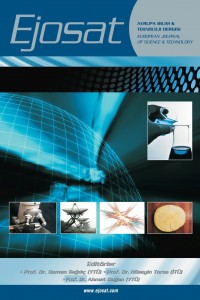Abstract
Bu makale, ortam enerji kaynakları için kendiliğinde başlayan bir ara devresi sunmaktadır. Önerilen devre bir voltaj katlayıcı, bir boost dönüştürücü, bir yük aktarım kontrol devresi ve bazı pasif devre elemanlarından oluşur. Voltaj katlayıcı, enerji kaynağının çıkışındaki düşük voltajı artırarak, bir çift katmanlı kapasitörde saklar. Çift katmanlı kapasitöre yeterli elektriksel yük depolandıktan sonra, yük aktarım devresi aktiv hale gelerek çift katmanlı kapasitör ile boost dönüştürücü arasında bir bağlantı kurar. Böylece, yüke kısa bir süreliğine güç sağlanır, yani enerji kaynağında üretilen güç, yükün gerektirdiği güçten daha düşük olduğu için yük burst modda çalışır. Boost dönüştürücü, yüke sabit bir voltaj seviyesi (örneğin 3.3 V) sağlamak için kullanılır. Önerilen devre, piyasadaki hazır cipler kullanılarak test edildi ve taklit edilen enerji kaynağına bağlandı. Enerji kaynağını taklit etmek için bir voltaj kaynağına seri bir direnç bağlanarak modellenebilir. Önerilen devre, en az 0.3 V giriş voltajında çalışmaya başlatılabilir ve 3.3 V’a yükseltebilir. Önerilen ara devresinin etkin bir şekilde çalıştığını göstermek için çeşitli yükler altında test edilmiştir. Önerilen ara devre, %11.56’lik bir verime sahiptir ve bu verim, önceki çalışmadaki ara devrenin veriminden daha yüksektir. Önceki çalışmadaki ara devresi ile karşılaştırıldığında, önerilen devre verimi 1.8 kat arttırır. Ölçülen sonuçlar, önerilen devrenin harici beslemeye ihtiyaç duymadan yüksek bir verim elde ettiğini gösterir.
References
- Wang, W., Cionca, V., Wang, N., Hayes, M., O’Flynn, B., & O’Mathuna, C. (2013). Thermoelectric energy harvesting for building energy management wireless sensor networks. International Journal Distributed Sensors Networks.
- ABLIC Inc., Energy harvesting powered by ultra-low power and ultra-low voltage operation boost charge pump for step-up dc-dc converter startup, S-8880A Datasheet, 2018.
- Vishay Siliconix, P-Channel 1.5V (G-S) MOSFET, Datasheet, 2011.
Abstract
This paper presents an efficient self-startup interface circuit for ambient energy sources. The proposed circuit consists of a charge pump, a boost converter, a charge transfer control circuit and some passive components. The charge pump boosts the low voltage at the output of the energy source to store the charge into a super capacitor. Once enough charge is stored into the super capacitor, the charge transfer control circuit has been active (i.e. being on) to bridge the super capacitor to the boost converter. Thus, the load receives power supply in a short period of time i.e., operates in the burst mode since the generated power at the energy source is lower than the power required by the load. The boost converter is used for providing a constant voltage level (e.g. 3.3 V) to the load. The proposed circuit has been evaluated using off-the-shelf components and connects to emulate the energy source. A voltage source in series with a resistor can be modeled to emulate the energy source. The proposed circuit can start the operation as low as 0.3 V input voltage and up-convert to 3.3 V. The proposed interface circuit has been tested for various loads in order to indicate the effectiveness of the circuit. The proposed circuit has a peak overall efficiency of 11.56 %, which is higher than the conventional interface circuit achieves. As compared to conventional interface circuit, the proposed circuit enhances the efficiency by 1.8 X. The measured results indicate that the proposed circuit achieves a high efficiency without the need of external supply.
Keywords
References
- Wang, W., Cionca, V., Wang, N., Hayes, M., O’Flynn, B., & O’Mathuna, C. (2013). Thermoelectric energy harvesting for building energy management wireless sensor networks. International Journal Distributed Sensors Networks.
- ABLIC Inc., Energy harvesting powered by ultra-low power and ultra-low voltage operation boost charge pump for step-up dc-dc converter startup, S-8880A Datasheet, 2018.
- Vishay Siliconix, P-Channel 1.5V (G-S) MOSFET, Datasheet, 2011.
Details
| Primary Language | English |
|---|---|
| Subjects | Engineering |
| Journal Section | Articles |
| Authors | |
| Publication Date | April 1, 2020 |
| Published in Issue | Year 2020 Ejosat Special Issue 2020 (ARACONF) |


